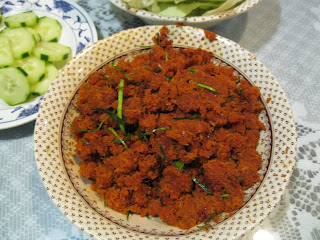Hi there,
This recipes has been a long time coming and is finally here. Today, 10th Nov. 2013, mummy has prepared to cook the dish which has become one of Nic's favourite dishes. Andrew introduced this dish to Nic when he was about 10 years old, I think, and he has come to enjoy it. Anyway, this time round, I was able to photograph the various ingredients and some of the steps of cooking this dish. Hopeful I would be able to write a comprehensive account of how to cook this delicious and delightful dish. Now everybody can follow the steps and cook this same dish and enjoy it.
The Ingredients: You will need the following:
(1) Half a kilogram of GOOD dry prawns. Make sure the dry prawns are the good, expensive ones.
(2) Half a kilogram of GOOD small onions (shallots). There are many types in the market. Ask the shop-keeper for the GOOD type, with an aromatic taste.
(3) About 12 to 14 sticks of lemon grass.
(4) About 2 inches of fresh yellow ginger. Fresh yellow ginger taste better than the powder type.
(5) A bundle of special lime leaves. Tai Ko Kum Huio (Daun limau perut)
(6) A handful of dry chilli, not the hot spicy ones. Ask the shop-keeper for the NOT spicy ones.
 |
| Picture1. These are some of the main ingredients that you need. Half kilo of small onions and dry prawns, 12 to 14 sticks of lemon grass, about 2 inches of fresh yellow ginger. |
 |
| Picture 3. Pick the best leaves, roll them up and cut the leaves into thin slices. |
 |
| Picture 4. The dry chilli are boil and let soak in the hot water to soften them for easy blending. |
 |
| Picture 5. The dry chilli has been soak in hot water and is now ready to be blended. |
 |
| Picture 6. The small onions are peeled, washed and ready to be blended. |
 |
| Picture 7. The dry prawns are checked for dry shells and any matters that should not be there before they are washed. |
 |
| Picture 8. The dry prawns are washed and now drip-dry in a big sieve, ready to be blended into fine fibers. |
 |
| Picture 9. The lemon grass are peeled, cleaned and ready to be cut into slices. |
 |
| picture 10. The lemon grass are cut into thin slices. The yellow ginger beside the chopping block is sufficient. |
 |
| Picture 11. The lemon grass and the fresh yellow ginger have been cut and ready to be blended. |
Methods:
Preparation:
You have to get ALL the ingredients ready before you can start cooking. If you have some helpers, then you can delegate the work to some of them. One helper can peel the small onions (Shallots). Another can wash and drip-dry the dry prawns, and after a few minutes, blend the dry prawns into fine fibers. Another helper can trim and wash the lemon grass and then cut into thin slices... cross wise. Ask another helper to boil the dry chilli for about ten minutes and then leave them to soak for another ten minutes to make them soft. Wash and peel the fresh yellow ginger and cut into smaller pieces. If you can multitask then you can do all the work by yourself. So while the dry chilli is boiling, you can wash and drip-dry the dry prawns. After that you can peel and wash the small onions . . . .
Blending:
(1) Blend the dry prawns first until fine. Put it aside.
(2) Blend the lemon grass with the cut yellow ginger until fine. Put it aside.
(3) Blend the dry chilli by itself until fine. Put it in a container and put it in the fridge.
(4) Blend the small onions. This doesn't have to be fine.
(5) Row the lime leaves and cut into thin slices. Put them aside. Use the medium aged leaves. They taste better then the old ones. The old ones are tougher and harder to chew.
 |
| Picture 12. The blended dry prawns is cooked separately in a hot wok without any oil. At this stage, controlling the fire is the most important factor here. |
 |
| Picture 13. The dry prawns cooked and scooped up ready to be added when the spices are cooking |
Cooking:
(1) Fry the blended dry prawns WITHOUT using any cooking oil until aromatic. This is where the control of the fire will determine the success or failure of this dish! Too low a fire, you will take a long time to finish cooking the dish. Too high a fire you will burn the prawns. So the trick is to alternate high and low fire to have a constant high heat without burning the dry prawns. Then scoop out the cooked dry prawns into a clean container and put it aside. This stage of pre-cooked dry prawns is very important to have a flavourful dish without a fishy smell! Some people didn't carry out this step and the dish tasted fishy.
 |
| Picture 14. With a clean wok, half a cup of oil is heated up before the spices ingredients are added in, one at a time. |
 |
| Picture 15. Fry the spices until aromatic. Control the fire and stir fry constantly to avoid burning the ingredients. This is a very crucial stage in the cooking process. |
(2) Pour half a cup of cooking oil into the wok, heat it up. Then add in the blended lemon grass together with the fresh yellow ginger, the blended small onions, blended dry chilli and stir fry until completely cooked and aromatic.
(3) Now put in the pre-cooked dry prawns and stir fry again, mixing everything well.
 |
| Picture 17. The lime leaves cut into thin slices are added and stir fry again to give the dish the typical aroma. |
(4) Finally, before you scoop it up, put in the cut lime leaves and stir fry again. At this time, you will smell the typical familiar aroma of "Sambai Hay Bee".
 | |
| Picture 18. The dish is ready to be served with sliced Japanese cucumbers and organic cabbage leaves. |
Pa.




No comments:
Post a Comment